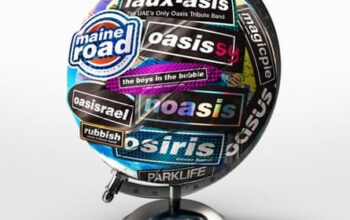If you attended a music festival this summer, you might have noticed that earplugs are having a moment. Earplugs were once ugly, disposable foam bullets that crudely muffled sound, but a new generation are reusable and designed to let a wider range of sound through while cancelling out frequencies that might lead to hearing problems. They’re also, for the first time, quite cool.
The brand with the most name recognition is Loop, which markets its products as a kind of jewellery, costing around £20 to £60. Loop partnered with prestigious UK dance festival Houghton, while rival player Alpine had concession stands at Boomtown, Elrow, All Points East and BST Hyde Park. For Jono Heale, a director of ACS Custom – whose moulded earplugs are considered music industry-standard – this stigma-free marketing is long overdue: “A few years ago, festivals felt they were admitting some kind of liability if they had us there. Recently, I’ve been contacted about working with more, I think because they’re getting worried.”
That worry might stem from hearing charity Tinnitus UK recently finding that 7.6 million Brits suffer from the condition, 1.5 million of them severely; in February, the World Health Organisation stated that “over 1 billion young adults are at risk of permanent, avoidable hearing loss due to unsafe listening practices”. The sense that this problem is affecting more and more young people is supported by writer and DJ Seb Wheeler, who guest edited Mixmag’s Tinnitus Awareness Week coverage this year. “Every time I post about tinnitus,” he says, “my DMs get flooded.”

Olivia Swash, a music journalist and podcast producer, started experiencing a mild form of tinnitus in her early 20s: “After going to gigs, bars or clubs that are too loud, without wearing earplugs, the ringing will be much worse for days afterwards.” She wears her Apple AirPods Pro on noise-cancellation mode at gigs – a recent New York Times study, while advocating for proper earplugs, showed that this reduces the decibels reaching your ears. “The sound is way better,” Swash says, “and I don’t really care if it looks weird.”
Most wisdom around what is considered safe is rooted in workplace heath and safety practices, as Matthew Allsop – an audiologist for Harley Street Hearing & Musicians’ Hearing Services who runs a YouTube channel devoted to hearing – explains: “In the UK, the safe threshold stands at being exposed to 85 decibels (dB) over an eight-hour period.” This is the limit at which an employer would need to provide PPE, such as ear defenders. “However, for every three decibels that threshold rises,” Allsop continues, “you halve time you can be safely exposed. So at 100dB, technically you can only be exposed for 15 minutes before you’ll start to damage your ears.”
Terrifyingly, an average club volume comes in at around 100dB, while according to the Musicians’ Union, even a classical orchestra can reach 94dB and a rock band can peak as high as 125dB. If, like me, you’re always down the front, the vibes might be stronger but the decibel toll gets even worse. Why do we put ourselves through this?
“People like a loud gig,” says Léon Pearce, who has mixed the sound for live performances by the Zutons, 10cc and Beth Orton. “It’s a visceral experience. That bone-shaking energy that thumps in your chest. It draws your attention. It’s too loud to talk to anyone, so you’re all feeling it together.” Heale agrees: “Human beings take in sound from our bodies through conduction, not just our ears. It increases our adrenaline levels when we feel sounds in our body.”
It can be hard to tear yourself away, but earplug retailers state that it’s important to take breaks, even when using their products. This view is echoed by Laurence Kendall, an audiovisual technician. “Give your ears a rest and find a spot in the crowd that feels more comfortable to your ears. Bass frequencies are actually not as harmful, so finding a spot where the high end is a bit rounded off will definitely help.”
Amid the rise in earplug use to combat hearing damage, there’s another, simpler solution: reduce the volume. But unlike earplug use, there’s still a stigma attached to asking someone to turn it down – it’s seen as incredibly uncool, even overbearing, despite the dangers of long exposure to loud noise. “I would never have thought to ask,” says Swash. “I would assume, perhaps incorrectly, that surely the sound engineer knows what they’re doing.”
after newsletter promotion
A rare voice advocating for the right to say “this is too loud” is Gregory Scott, founder of the SoundPrint app. This global database of noise-level readings, openly sourced by its users, was formed “to help people find quiet venues which are more conducive to conversation and protect people’s hearing health in the process”, Scott says. SoundPrint’s findings show, for example, that London has the loudest bars and restaurants in Europe – not a surprise to anyone that’s tried to go on a romantic date in the capital.
“It’s hard to know for certain if a place is too loud,” continues Scott, whose app features a decibel reader that you can show to a venue manager. “People think there’s a stigma around being the one to raise the issue of noise. But as the world gets louder, it’s doing damage to our bodies that we can’t ignore.”
Source: theguardian.com


